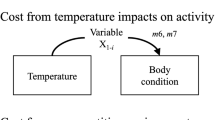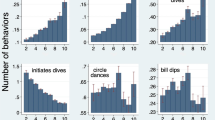Summary
To test theories recently proposed to explain territorial dominance in animals, we performed several versions of experiments in which male red-winged blackbirds were removed from their territories, held in captivity for varying periods, and then released to challenge their replacements. Males removed for 7 to 49 h recovered their territories from replacement males, either when released or over the following few days or weeks. The duration males were held off territory, the duration replacement males occupied territories, and the original owners' awareness before fighting that they had been replaced, apparently did not influence contest outcomes, but whether the new owner was a neighbor or a previously non-territorial male had some effect. The pattern of territory recovery observed most closely supports the hypothesis that territorial dominance in redwings arises from asymmetries in local knowledge and experience between owners and challengers, although another hypothesis, the Resource Holding Potential hypothesis, was not entirely ruled out. We discuss design of removal experiments to test territoral dominance, and propose that ecologies of particular species may powerfully influence outcomes of these experiments.
Similar content being viewed by others
References
Beletsky LD, Orians GH (1987) Territoriality among male Redwinged Blackbirds. I. Site fidelity and movement patterns. Behav Ecol Sociobiol 20:21–34
Charles JK (1972) Territorial behaviour and the limitation of population size in crown, Corvus corone and C. cornix. Unpubl Ph D thesis, University of Aberdeen, Scotland
Davies NB (1978) Territorial defence in the speckled wood butterfly (Paraarge aegeria): the resident always wins. Anim Behav 26:138–147
Hansen AJ, Rohwer S (1986) Coverable badges and resource defence in birds. Anim Behav 34:69–76
Harris MP (1970) Territory limiting the size of the breeding population of the Oystercatcher (Haematopus ostralegus)—a removal experiment. J Anim Ecol 39:707–713
Holcomb LC (1974) The question of possible surplus females in breeding Red-winged Blackbirds. Wilson Bull 86:177–179
Kacelnik A (1979) Studies of foraging behaviour and time budgeting in great tits (Parus major L.). Unpubl PhD thesis, University of Oxford
Knapton RW, Krebs JR (1974) Settlement patterns, territory size, and breeding density in the song sparrow (Melospiza melodia). Can J Zool 52:1413–1420
Krebs JR (1971) Territory and breeding density in the great tit Parus major L. Ecology 52:2–22
Krebs JR (1982) Territorial defence in the Great Tit (Parus major): Do residents always win? Behav Ecol Sociobiol 11:185–194
Maynard Smith J (1979) Game theory and the evolution of behaviour. Proc Royal Soc London B 205:475–488
Maynard Smith J, Parker GA (1976) The logic of asymmetric contests. Anim Behav 24:159–175
Nero RW (1956a) A behavior study of the Red-winged Blackbird. I. Mating and nesting activities. Wilson Bull 68:5–37
Nero RW (1956b) A behavior study of the Red-winged Blackbird. II. Territoriality. Wilson Bull 68:129–150
Orians GH (1961) The ecology of blackbird (Agelaius) social systems. Ecol Monogr 31:285–312
Orians GH (1980) Some adaptations of marsh-nesting blackbirds. Princeton University Press, Princeton
Orians GH, Christman GM (1968) A comparative study of the behavior of Red-winged, Tricolored and Yellow-headed Blackbirds. Univ Calif Publ Zool 84:1–81
Owen DF (1954) The winter weights of titmice. Ibis 96:299–309
Parker GA (1974) Assessment strategy and the evolution of fighting behaviour. J Theor Biol 47:223–243
Parker GA, Rubinstein DI (1981) Role assessment, reserve strategy and acquisition of information in asymmetric animals conflicts. Anim Behav 29:221–240
Petrie M (1984) Territory size in the Moorhen (Gallinula chloropus): an outcome of RHP asymmetry between neighbors. Anim Behav 32:861–870
Ridley M, Thompson DJ (1979) Size and mating in Asellus aquaticus (Crustacea: Isopoda). Z Tierpsychol 51:380–397
Riechert SE (1978) Games spiders play: behavioural variability in territorial disputes. Behav Ecol Sociobiol 3:135–162
Rohwer S (1982) The evolution of reliable and unreliable badges of fighting ability. Am Zool 22:531–546
Smith DG (1976) An experimental analysis of the function of red-winged blackbird song. Behaviour 56:136–156
Watson A (1967) Territory and population regulation in the Red Grouse. Nature 215:1274–1275
Yasukawa K, Bick EI, Wagman DW, Marler P (1982) Playback and speakerreplacement experiments on song-based neighbor, stranger and self discrimination in male Red-winged Blackbirds. Behav Ecol Sociobiol 10:211–215
Author information
Authors and Affiliations
Rights and permissions
About this article
Cite this article
Beletsky, L.D., Orians, G.H. Territoriality among male red-winged blackbirds. Behav Ecol Sociobiol 20, 339–349 (1987). https://doi.org/10.1007/BF00300680
Received:
Accepted:
Issue Date:
DOI: https://doi.org/10.1007/BF00300680




